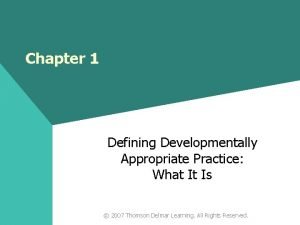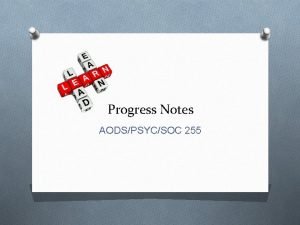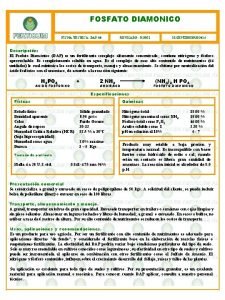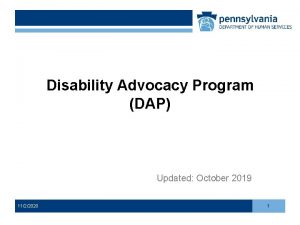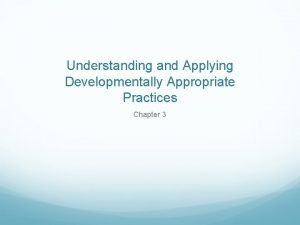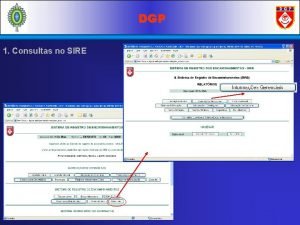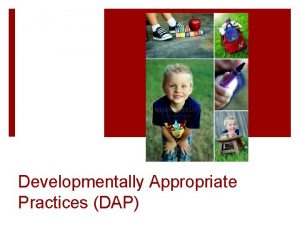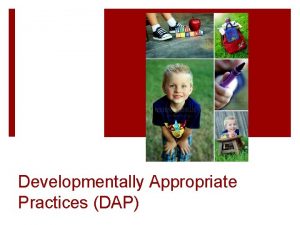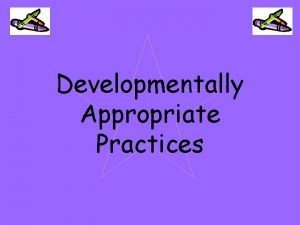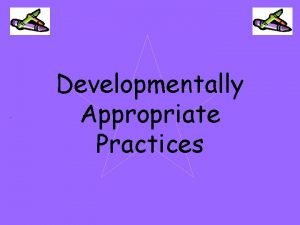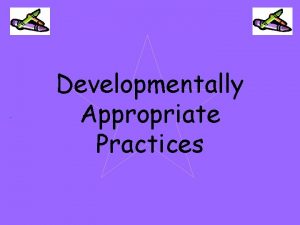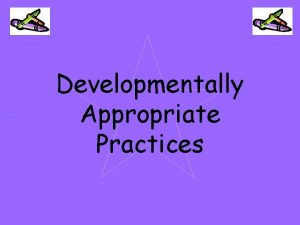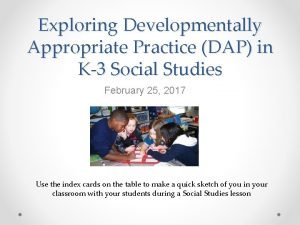DEVELOPMENTALL Y APPROPRIATE PRACTICES DAP Types of Learning


















- Slides: 18


DEVELOPMENTALL Y APPROPRIATE PRACTICES DAP

Types of Learning Active Learning • actively involved and engaged in the learning by doing, seeing, and • thinking. Passive Learning • sitting and listening • without interaction.

Forms of Education 1. ADULT DIRECTED: Teacher decides what to do and how to do it. • Teacher controlled: Pre-cut, pre-drawn, instructions on how to assemble it, samples 2. ADULT INITIATED: Child has creativity, but adult initiates the idea of making something and chooses the supplies to be used. • Teacher provides materials: paper, cotton, glue. . Now use these to make… 3. CHILD DIRECTED, CHILD INITITATED, and TEACHER SUPPORTED: Child decides what to do, the idea, and the material to use. Adult follows the child's lead. • Child chooses: supplies, play items, idea and teacher encourages There is a time and place for all 3. When could you see these forms of education happening?

DAP Curriculum • Includes all areas of development Cognitive Social Emotional Physical

• A variety of stimuli, activities, and materials • Encourages uninhibited, active exploration and investigation. • Challenges child to solve mysteries/problems on their own. Adults help kids too much!

• Concrete • Hands on, touch, manipulate • Learn by doing • Relevant • Interests • Real • Part of daily life

Developmentally Appropriate is: • Designing curriculum to match how children learn and develop then • Recognizing the child’s capability and challenging their ability • Individual • Each child is an individual • Age appropriate • Ages and stages as a guide • Multi cultural/Non- sexist in activities, materials, and equipment.

DIP Lesson vs. DAP Lesson Nobody learns anything sitting on their bottoms!

Apple Activity: • Get in small group • Card and pencil • Look at the apple you are given • In 30 seconds write down as much as you can about the apple you have.

Apple Activity: • Get in same small group • Card and pencil • Get tools and towel • Discover the apple you are given • Write down as much as you can about the apple you have.

• NOT TIME SCHEDULED • Time to explore • Free choice…child can move freely between activities. • Balance resting time and active movement

DAP Atmosphere is: • Children actively participating. • Full of questions, comments, or interruptions, or something is wrong. • Often noisy with laughter, questions, and talking. • High quality playtime Seed plant

Why DAP Works • Tell me…. I forget • Show me…. I remember • Involve me…. I understand

QUALITY DAP TEACHERS KNOW THAT Children are Active (not passive) Learners so they. . • Give children opportunities for gross motor activities each day. • Keep inactive segments short. • Provide free-choice periods. • Adapt to differing styles and abilities • Provide many opportunities for children to communicate • Facilitate successful completion of tasks. • Recognize that children learn through trial and error . • Build activities around children’s interests. • Provide many chances for children to explore. • Encourage children to pose problems and investigate solution. • Facilitates development of self control • Allow for increasing independence as child acquires skills

QUALITY DAP TEACHERS KNOW THAT Children are Playful so they. . • Integrate play throughout the day. • Provide variety of props and manipulative objects. • Encourage children to create and use their own ideas. • Create a classroom design and schedule that allows children to move about freely. • Recognize that high quality play is often noisy. • Make it fun by teaching with excitement and enthusiasm for learning. • Risk looking silly, loosing perfect discipline, and showing emotion. • Experience it with the child because learning should be a walk of discovery, not a race to the finish line.

QUALITY DAP TEACHERS KNOW THAT Children are our Future so they. . • Respond quickly to each child’s needs • Be alert to signs of stress in children’s behavior. • Build self-concept by • Respecting, • Accepting, and • Comforting the child regardless of the behavior

DAP Reaction Paper • Answer the questions on your paper. Use your notes if needed. • Use the back to discuss your honest reaction to the teaching with DAP methods. • Use the prompt questions to help you write your ½ page reaction. • Turn in!!
 Types of dap
Types of dap Developmentally appropriate programs are based on
Developmentally appropriate programs are based on Dap note example
Dap note example Cif paritet
Cif paritet Gillman hipaa progress note
Gillman hipaa progress note Ficha tecnica dap
Ficha tecnica dap Ssi vs ssdi
Ssi vs ssdi Dap
Dap Data science dap
Data science dap 12 prinsip dap
12 prinsip dap 10 effective dap teaching strategies
10 effective dap teaching strategies Dap pn
Dap pn What is dap
What is dap 12 prinsip dap
12 prinsip dap Dgp sire
Dgp sire Dap 1525
Dap 1525 Cuadro comparativo e-learning b-learning m-learning
Cuadro comparativo e-learning b-learning m-learning All verb moods
All verb moods The appropriate cutting tool used in cutting fabrics
The appropriate cutting tool used in cutting fabrics

